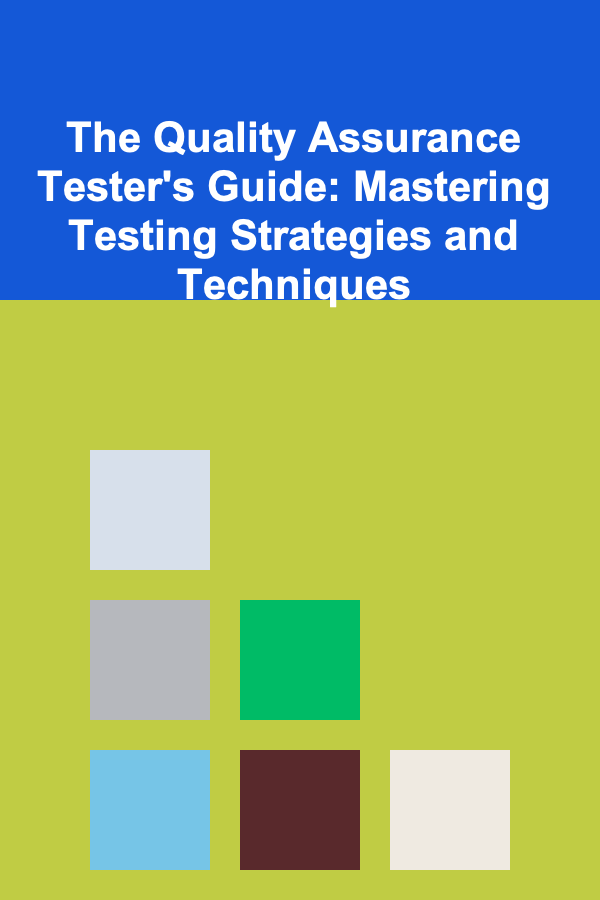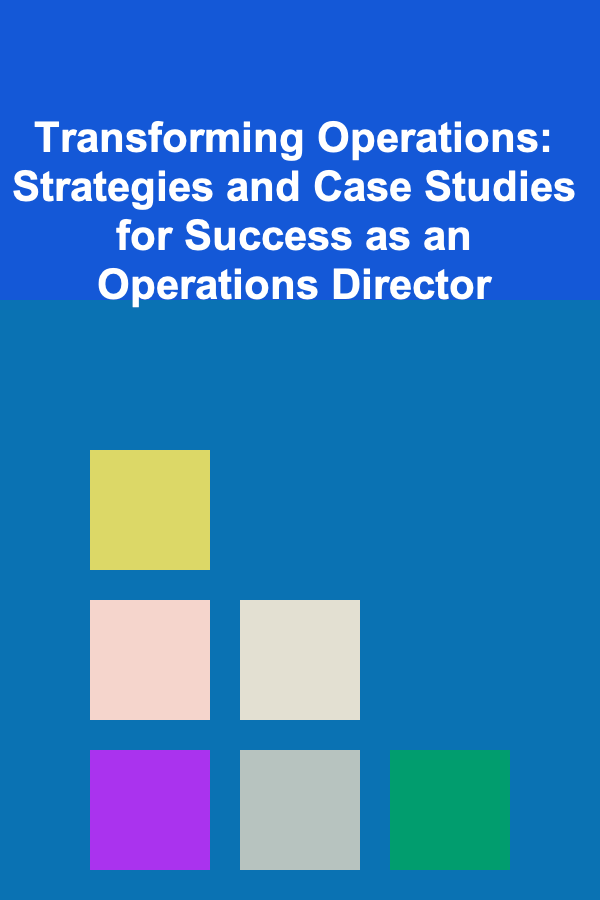
How to Create a Checklist for Collecting Event Feedback and Surveys
ebook include PDF & Audio bundle (Micro Guide)
$12.99$8.99
Limited Time Offer! Order within the next:

Collecting feedback and surveys after an event is essential for understanding the overall success, gathering insights for improvements, and measuring attendee satisfaction. Whether it's a corporate conference, a product launch, a wedding, or any other type of event, having a structured checklist will ensure that you collect the most valuable data and that your feedback process is efficient and organized.
Creating a comprehensive feedback checklist helps streamline the process and guarantees that you don't miss any critical elements that could influence your post-event analysis. This actionable guide will walk you through creating a checklist for collecting event feedback and surveys, ensuring you can gather meaningful data for future improvements.
Define the Goals of Feedback Collection
Before you create the actual checklist, you must be clear about the purpose of collecting feedback. What do you hope to achieve with the surveys? Are you interested in improving the event logistics, enhancing the experience for future attendees, or measuring specific KPIs (e.g., engagement, satisfaction, or content relevance)? By setting clear objectives, you can tailor your feedback form to gather the right type of information.
Key Questions to Ask:
- What specific aspects of the event do I want feedback on? (e.g., venue, speakers, content quality, food)
- What action will be taken with the feedback collected?
- What are the key performance indicators (KPIs) for this event?
Why This Matters:
Setting clear objectives helps shape the feedback process and ensures you focus on the most critical areas. Without defined goals, you may end up with irrelevant or scattered data that won't provide actionable insights.
Determine the Feedback Method
Next, decide how you'll collect the feedback. Will you distribute online surveys via email or use a physical form at the event? Understanding the feedback method will affect how you design your checklist.
Common Methods for Collecting Feedback:
- Online Surveys: Platforms like Google Forms, SurveyMonkey, or Typeform are widely used for collecting post-event feedback. They allow for customization, automation, and easy analysis.
- Mobile Apps: If your event has a dedicated app, you can integrate feedback collection directly within the app for real-time responses.
- Paper Surveys: If your event is in-person and lacks online engagement tools, paper surveys may be appropriate.
- Social Media and Direct Messaging: Some events choose to use social media platforms or direct messages to collect informal feedback from attendees.
Why This Matters:
Choosing the right feedback method ensures a smooth collection process and encourages higher response rates. For example, online surveys are more effective for larger events, while in-person surveys might work best for smaller, more intimate gatherings.
Design the Survey Questions
Once you have the goals and methods in place, it's time to design the survey. The quality of your questions directly impacts the quality of the feedback you receive. Ensure that your questions are clear, unbiased, and easy to answer.
Types of Survey Questions:
- Closed-ended questions : These are structured questions with a limited set of responses (e.g., Yes/No, multiple choice). They are easy to analyze but may not provide deep insights.
- Example: Was the event venue easy to find? (Yes/No)
- Rating Scale Questions : These questions ask respondents to rate a specific aspect of the event on a scale (e.g., 1 to 5, or 1 to 10). This is useful for measuring attendee satisfaction and gathering quantitative data.
- Example: On a scale of 1-5, how satisfied were you with the event speakers?
- Open-ended questions : These allow attendees to provide detailed feedback. While they take longer to analyze, they provide qualitative insights that can highlight specific issues or suggestions.
- Example: What was the highlight of the event for you?
- Likert Scale : These questions assess attitudes or perceptions on a specific statement, asking attendees to agree or disagree to varying degrees.
- Example: The content of the event was valuable to my professional development. (Strongly Agree, Agree, Neutral, Disagree, Strongly Disagree)
Best Practices for Writing Questions:
- Keep them concise and specific to the event.
- Avoid leading or biased questions (e.g., "How amazing was the event?").
- Use a mix of question types to gather both qualitative and quantitative feedback.
Why This Matters:
A well-structured survey can help you get valuable, actionable data that aligns with your objectives. Poorly designed questions, however, can lead to skewed or unusable feedback, wasting your time and effort.
Decide on Timing for Collecting Feedback
The timing of when you send out the feedback forms or surveys plays a significant role in the quality of responses.
Ideal Times for Collecting Feedback:
- Immediately After the Event: For the best recollection of the event, send the survey immediately after it ends (within 24 hours). This ensures the experience is fresh in attendees' minds.
- Follow-up Surveys: Sometimes, sending a follow-up survey a few days or weeks after the event is helpful, especially if the feedback is more about long-term value (e.g., how the content impacted their work).
Considerations for Timing:
- Event Length: For multi-day events, consider sending smaller, mid-event surveys to gauge real-time feedback.
- Availability of Attendees: Some attendees might need a break after the event or may not be able to fill out the survey immediately. Consider your audience's availability before sending the feedback request.
Why This Matters:
The timing of the survey can impact the response rate and the quality of feedback. Sending surveys at the right moment maximizes engagement and ensures that attendees can provide thoughtful, relevant responses.
Ensure Anonymity and Privacy
Anonymity and privacy are crucial factors in obtaining honest and constructive feedback. Attendees are more likely to provide candid responses if they feel their answers will not be traced back to them, especially if the feedback is critical.
Key Actions:
- Offer Anonymous Responses: Clearly state that survey responses are anonymous to encourage more honest feedback.
- Data Protection: If you're collecting personal data (such as names or contact details), ensure compliance with data protection regulations like GDPR or CCPA.
Why This Matters:
Confidentiality and privacy encourage honest feedback, reducing the risk of biased responses. Additionally, respecting privacy builds trust with attendees and shows that you value their opinions.
Set Up a System for Analyzing the Feedback
Collecting feedback is only half the process. The next step is to analyze the responses to gain actionable insights. You should set up a system for reviewing and organizing the data you receive.
Tools for Analyzing Feedback:
- Spreadsheet Programs: Use tools like Excel or Google Sheets to sort and filter responses. You can create graphs or pivot tables to visualize patterns and trends.
- Survey Analytics Tools: Platforms like SurveyMonkey or Typeform offer built-in analytics features to help analyze the data automatically.
- Manual Analysis: If your survey contains many open-ended questions, consider categorizing common themes or recurring feedback manually.
Why This Matters:
Proper analysis of feedback helps you extract valuable insights that can inform future events. Without a clear system, you might miss key trends or critical issues that need addressing.
Act on the Feedback
Once you've analyzed the data, it's time to act on it. Feedback is only valuable if you use it to improve future events. You can share findings with your team, adjust your event strategy, and address any pain points highlighted by attendees.
Ways to Act on Feedback:
- Share Results: Share the findings with your team or stakeholders to ensure everyone is on the same page and aligned for future events.
- Implement Changes: Use the feedback to improve specific aspects of the event, whether it's venue selection, speaker choice, or logistics.
- Close the Loop with Attendees: Consider sending a follow-up email thanking attendees for their feedback and letting them know how their input will be used to improve future events.
Why This Matters:
By acting on feedback, you demonstrate that you value attendee opinions and are committed to improving the overall experience. This builds trust and encourages future participation.
Conclusion
Creating a comprehensive checklist for collecting event feedback and surveys is essential for gaining valuable insights that can help you improve future events. By defining clear goals, designing the right survey questions, choosing the appropriate feedback methods, and analyzing the data effectively, you can gather actionable feedback that drives improvements and enhances attendee experiences. Collecting feedback shouldn't be an afterthought but a core part of your event planning process to ensure that you continuously evolve and provide the best possible experiences for your attendees.

Building Stronger Relationships: Interpreting Customer Feedback and Gleaning Valuable Insights
Read More
How to Build an Effective Online Store for Selling US Products
Read More
How to Maintain Your Wind Turbine for Longevity
Read More
How to Make Money Online as a Video Game Designer: 10 Actionable Ideas
Read More
The Quality Assurance Tester's Guide: Mastering Testing Strategies and Techniques
Read More
Transforming Operations: Strategies and Case Studies for Success as an Operations Director
Read MoreOther Products

Building Stronger Relationships: Interpreting Customer Feedback and Gleaning Valuable Insights
Read More
How to Build an Effective Online Store for Selling US Products
Read More
How to Maintain Your Wind Turbine for Longevity
Read More
How to Make Money Online as a Video Game Designer: 10 Actionable Ideas
Read More
The Quality Assurance Tester's Guide: Mastering Testing Strategies and Techniques
Read More